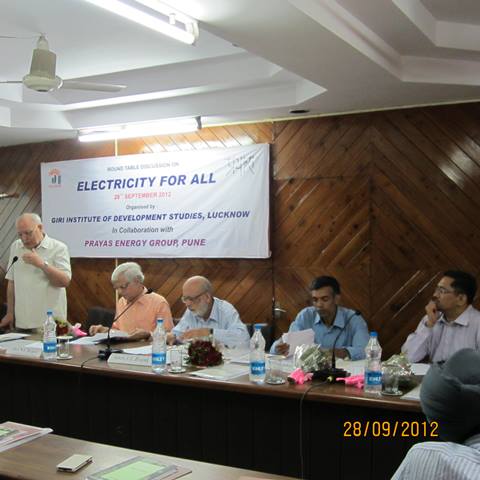Giri Institute of Development Studies (GIDS), Lucknow and Prayas Energy Group (Prayas), Pune jointly organised a round table on “Electricity for All” at Lucknow on September 28, 2012. The objective of the round table was to discuss challenges and approaches to ensure electrification for all households in India with focus on UP.
Senior officials from the electricity sector such Shri. J L Bajaj, former Chairman UPERC, Shri. N C Bajpai Deputy Chairman of UP State Planning Commission, researchers and civil society organisations participated in this discussion. Electricity access plays a key role in facilitating economic growth and improving quality of life leading to overall development. State and Central governments have taken up massive rural electrification programs like the Rajiv Gandhi Grameen Vidyutikaran Yojana (RGGVY). The central government had allocated a subsidy of Rs. 33,000 crore for RGGVY in the Tenth and Eleventh plans, and similar allocation is proposed in the Twelfth plan.
This has resulted in significant improvement in village and household electrification across the country. In UP, there has been some improvement in village and rural household electrification. Village electrification in UP is 88% (compared to national average of 91%) but still only 24% of rural households have electricity connection compared to national average of 55% as of 2011. It is clear that the target of “Electricity for All” is far from being met due to delays in providing connections and limitations in providing sufficient hours of electricity supply to villages.
One approach for addressing this issue, suggested by Prayas, is a scheme for transferring low cost power to Distribution Companies, especially of states like UP, Bihar, West Bengal, Odisha, MP and Rajasthan which account for 75% of the non-electrified households in India. This would require about 14,000 MW of power and if implemented, 7 crore households in backward areas, accounting for 28% of population can benefit from such scheme. Everybody agreed that in order to ensure household electrification, subsidy for supply is as important as subsidising access. Both Shri. Bajaj and Shri. Bajpai agreed that there is need for developing approaches that will address the distribution company’s structural disincentive.


